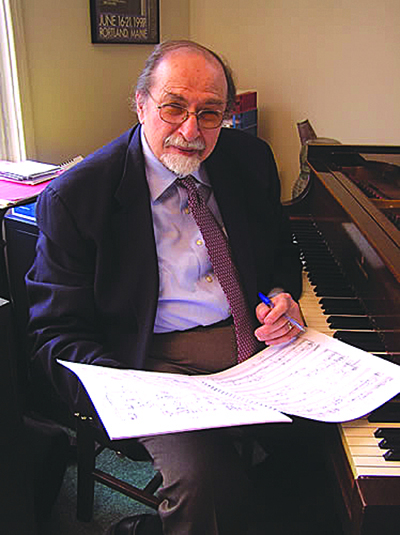I recently spoke with composer Elliott Schwartz about his “Diamond Jubilee,” which will be performed by the Portland Symphony Orchestra on Jan. 25, a week after his 75th birthday.
In spite of being brought up in Brooklyn and graduating from Columbia University, Schwartz might be considered a Maine composer — he taught at Bowdoin College from 1964 to 2007, and his father grew up in Portland — but his reputation is international.
His works have been played and recorded by a lengthy list of orchestras and chamber music groups the world over, and he has taught and lectured from Tokyo to Reykjavik. Like other composers before him, he has also written extensively on musical topics. Schwartz is one of the pioneers of electronic music, and his “Electronic Music: A Listener’s Guide” is one of the standard books on the subject.
“Diamond Jubilee” was commissioned by the PSO, which also provided some input about the way it will be presented (with visual effects).
Schwartz emphasizes, however, that it is not going to be “a slide show with soundtrack.”
The projected images will be icons of the three 25-year periods in the composer’s life, each of which is recalled in the three movements of what might be called a mini-symphony (17½ minutes in length).
PSO principals are featured in the solo cadenzas that open each movement, written for friends and associates Thomas Parchman, clarinet; Laurie Kennedy, viola; and John Boden, horn.
The new work employs a technique that Schwartz has used in other compositions: constructing a musical motif from the letters in a name. Schumann’s “Carnival” is probably the best-known example in the classics, but others, from Bach to Brahms, have done the same thing.
“Diamond Jubilee” begins with a four-note theme in which middle C is one, the next note a ninth above, then a third above, and then a sixth to make 1936, the date of Schwartz’s birth. After a three-note recapitulation a half step higher comes a 12-note tone row based on the composer’s full name, which, with the addition of “ti” (la-ti-da), “gives you seven notes; then it’s easy to add the next five for the tone row,” he said.
All of this may sound academic, but the result is far from it. The “1936” segment forms a striking and recognizable passage and a ninth chord that Debussy would have liked, while the tone row becomes a fascinating pattern in ascending and descending seconds that is developed and transformed throughout the work.
The composer points out that the tone row is not treated in the kind of development that Schoenberg would have approved. In fact, “Diamond Jubilee” has quite a few tonal passages.
The newly composed sections alternate with flashbacks to Schwartz’s own music, including works written earlier for the PSO. And the evening wouldn’t be complete without vocalizations by orchestra members, harmonica playing, electronic interludes and a chorus of real cell phone ringtones.
Other musical materials include Jewish holiday memories, a Victorian parlor song based on a Longfellow poem, music composed for the memorials of dear friends, and a quotation (which Schwartz says is impossible to miss) “which I had borrowed for a 1997 piece celebrating international brotherhood. I’d like to think this is an appropriate way to celebrate hope for the future.”
Christopher Hyde is a writer and musician who lives in Pownal, He can be reached at:
classbeat@netscape.net.
Send questions/comments to the editors.



Success. Please wait for the page to reload. If the page does not reload within 5 seconds, please refresh the page.
Enter your email and password to access comments.
Hi, to comment on stories you must . This profile is in addition to your subscription and website login.
Already have a commenting profile? .
Invalid username/password.
Please check your email to confirm and complete your registration.
Only subscribers are eligible to post comments. Please subscribe or login first for digital access. Here’s why.
Use the form below to reset your password. When you've submitted your account email, we will send an email with a reset code.